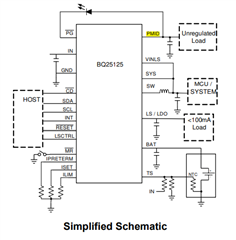Dear all,
A couple questions regarding the BQ25125 please.
1- What is the difference between the LDO and LS. I understand the LDO is the regulated output, but I am not sure what it means when it is selected as load switch, please?
2- My understanding is when the BQ25125 is selected as a ship mode enable to be enable restore the power is hold the button connected to the MR low for a designated time. Second way is to restore the power by
inserting power to the Vin.
3- If we connect the MR pin to a switch use for other purposes would it be, okay?
Thanks.





